When it comes to Extreme Truck Campers (XTC's) and exploring off-road, few people know more than Jeffrey Reynolds. Known as Jefe 4x4 on the Internet forums, Jeff embarked on his first off-road adventure in 1965 and hasn't looked back since. He's owned a dozen 4x4 vehicles of various makes and has traveled well over a million miles in them. In the 1990s he worked as a staff writer on the Jeep section of Off-Road.com then later wrote articles for 4x4Wire.com about the nuts-and-bolts of 4x4 drive-trains. In 2001 he bought a Lance camper to go on his Dodge short-bed pickup truck and his whole world changed from rock crawling in Jeeps and other 4x4 vehicles to less extreme off-road exploring in a truck camper. Now at age 70, Jeff is in the "December" of life, but still shows no sign of letting up as he continues to explore exotic locales in the American west.
Mike: Thanks again Jeff for taking the time to talk. How did you acquire the nickname, Jefe?
Jefe: The nickname, Jefe, pronounced Hay’-fay, which means the boss or chief in Spanish was pinned on me during my tenure as a bass trombonist with the Los Angeles Philharmonic (1969-2006).
Mike: Why is the name Cabeza de Vaca stenciled on the rear door of your camper?
Jefe: Cabeza de Vaca is a mystical character and his family name is a double entendre. Firstly, I've read all the books about this itinerant explorer and his travels starting with his shipwreck on the west coast of Florida during a hurricane, making his way through the later-to-be Gulf states and west to near the Pacific coast and south eventually to what is now Mexico City to be picked up and taken back to Spain in the early 1500's. This little ditty took him ten years, at which time he was forced into slavery a couple times by the now-extinct indian tribes; was naked half the time, and almost died of dehydration, starvation, sickness, flogging, over exposure, over and over again. I kind of identify with this guy. Secondly, a side shot of our truck camper gives a hint of a cow's head if you put eyebrows on the front-side windows.
Mike: How long have you been RV'ing?
Jefe: Since 1965. The definition of an RV is a vehicle with accoutrements for eating, and sleeping inside, with or without a bathroom space. In that regard, we camped in all the larger 4x4's, out of the weather, and mostly in very cramped mode. If your definition includes plumbed water, two showers, a wet bath, a dining area, a 3-way refrigerator, heat and a queen size bed, then the first year was 2001.
Mike: What truck camper do you presently own and why did you choose that make and model for your XTC?
Jefe: Once we had a car trailer to get my rock rig to the trail-head, then we thought about a small hard side truck camper to go along with it. I opened the Recycler and found a 1998 Lance Squire Lite 165-s. I called the guy. I looked at it. He used it three times. It chose me. I followed him to the bank and wrote a check. The whole thing went down on the same day. Just lucky I guess. My wife, Jeanie, and I have camped in it over 200 nights.
Mike: Do you tie down and rig your Lance camper a certain way to take it off-road?
Jefe: Without a 3-point or 4-point truck camper attachment system on a flatbed, I have relied on "working" the four tie downs to be appropriate to the road surface. The frames on all pickup trucks are built to flex/tweak/rack. The truck bed will flex right along with it. This all depends on road surface and how twisted up you allow the axles. If you do not considerably loosen the rearmost tie-downs crawling over an undulating road surface, the twisting frame will try to pull your truck camper apart, little by little, by making the camper conform to the truck bed and frame twisting. Why the rearmost? In jacking the truck camper up above the truck bed for removal, I noticed most of the weight of the truck camper is on the forward jacks. Hmm? Little weight on the rear, at least on mine. I allow the rear of the truck camper frame to "float" and actually lift off the bed on one side or the other, trying not to conform to the twisting frame/bed, just follow the attitude of the front tie-downs. For off-roading, there is no room for camper jacks. They are just heavy outriggers ready to make contact with a slowly passing boulder. I remove them as soon as the camper is on the truck and leave them at home. Another issue I have pursued is to store nothing on the roof; all weighty items should be stored as low as possible. Potato chips, tea bags, and beer cozies; up high.
Mike: What measures do you take to prevent your Lance camper from shifting and sliding around in your truck bed?
Jefe: A thin, heavyweight bed mat and Lance camper brackets (aka centering guides) are a good start. I went through all the other permutations including; a fiberglass bed liner (huge mistake as the camper just skated around), a thick rubber mat (too spongy which increases your side-to-side sway) and nothing but the bed, which is pretty tough on the bottom of your truck camper. I tried without the brackets but the truck camper still would slide from side-to-side putting inordinate stress on the tie-downs, especially when you loosen the rear for axle twisting. There is only one way the camper can move now and that's rearward when the tie-downs are very loose. The Dodge has a footman's loop on each side outboard of the tailgate which could use a 1,000 pound strap to hold the box in the bed. I have had the camper try to make it's way out the back going up steep hills for miles but it doesn't get very far. The strap should contain the egress.
Mike: What modifications have you made to your truck camper and why did you decide against going solar?
Jefe: Solar power is very inviting, but with all those tree branches dragging on the aluminum roof and the weight of solar panels up high, I think I’ll pass for this lifetime. I purchased the model with no air conditioning, nor a built-in generator to keep the weight down. On off-season trips we take the Honda EU2000i on the off chance we need to run a house current device or charge batteries. I have some mods I’d like to make on the truck camper. I would like to loose both the front window and the pass through window as I find them useless and only there to transmit cold and heat, add weight and leak. If I had the 4-season insulation package, I would be happy as we are non-summer campers. In the end, I think I bought the right truck camper for us as there is very little I would change. You know, if it’s paid for, it fits your needs; and you are accustomed to and can work around its foibles, you might be a happy camper.
Mike: What pickup truck do you presently drive and why did you choose that make and model?
Jefe: I purchased my 2001 Dodge 2500 4x4 pickup truck brand new at the dawn of the diesel wars. I purchased it because it was the first year for a 35 spline, Dana 80 rear axle, the Cummins HO turbo diesel engine that used a bullet proof NV6500, 6-speed transmission, an NV241HD (wide chain to absorb the shock loading during snow plowing), disc brakes all around, and could run on third-world diesel fuel with pretty good mpg. No smog device. No soot bag. No urea canister. Not as simple as the first generation Cummins, but with a much more stout drive train. My choices had to do with tradeoffs. Notice my choice was focused on drive train strength and survivability, certainly not Dodge’s notoriously flimsy fit and finish. Oh, and it was the only truck engine and drive train that year in which I had any confidence about it outlasting me. So far, so good at 150,000 miles.
Mike: What off-road modifications have you made to your truck?
Jefe: If you choose your truck camper well, most of your mods will be to the truck. During the last decade I've made the following mods:
Jefe: At one time I did a lot of towing with the GCVW above 16,000 lbs. For big and heavy I like an oil burner. It's just more efficient than a gas engine. I’ve had many diesel cars (1964 MB200D, 1979 Cadillac Seville diesel, 1980 International Harvester Scout II Traveller Nissan TD, 1981 VW Dasher diesel, and 1983 Peugeot 505S TD) and I got used to the quirks of oil burners. If I were to buy another, say, 350/3500 that would only see occasionally use, I would look for a used Ford or Dodge V-10 gas platform. If you are not in it for the very long haul, or do not plan on much driving, the V-10 gas gets the job done without the $5,000-10,000 diesel penalty.
Part two of this fascinating and informative interview with Jefe can be found by clicking here.
Mike: Thanks again Jeff for taking the time to talk. How did you acquire the nickname, Jefe?
Jefe: The nickname, Jefe, pronounced Hay’-fay, which means the boss or chief in Spanish was pinned on me during my tenure as a bass trombonist with the Los Angeles Philharmonic (1969-2006).
Mike: Why is the name Cabeza de Vaca stenciled on the rear door of your camper?
Jefe: Cabeza de Vaca is a mystical character and his family name is a double entendre. Firstly, I've read all the books about this itinerant explorer and his travels starting with his shipwreck on the west coast of Florida during a hurricane, making his way through the later-to-be Gulf states and west to near the Pacific coast and south eventually to what is now Mexico City to be picked up and taken back to Spain in the early 1500's. This little ditty took him ten years, at which time he was forced into slavery a couple times by the now-extinct indian tribes; was naked half the time, and almost died of dehydration, starvation, sickness, flogging, over exposure, over and over again. I kind of identify with this guy. Secondly, a side shot of our truck camper gives a hint of a cow's head if you put eyebrows on the front-side windows.
Mike: How long have you been RV'ing?
Jefe: Since 1965. The definition of an RV is a vehicle with accoutrements for eating, and sleeping inside, with or without a bathroom space. In that regard, we camped in all the larger 4x4's, out of the weather, and mostly in very cramped mode. If your definition includes plumbed water, two showers, a wet bath, a dining area, a 3-way refrigerator, heat and a queen size bed, then the first year was 2001.
Mike: What truck camper do you presently own and why did you choose that make and model for your XTC?
Jefe: Once we had a car trailer to get my rock rig to the trail-head, then we thought about a small hard side truck camper to go along with it. I opened the Recycler and found a 1998 Lance Squire Lite 165-s. I called the guy. I looked at it. He used it three times. It chose me. I followed him to the bank and wrote a check. The whole thing went down on the same day. Just lucky I guess. My wife, Jeanie, and I have camped in it over 200 nights.
 |
| A 1965 shot of Jefe and his 1949 flat-fender Jeep wagon. |
 |
| Jefe and his 1966 Toyota Land Cruiser. |
 |
| Rock crawlin' in his 1982 CJ8 Jeep Scrambler. |
Mike: Do you tie down and rig your Lance camper a certain way to take it off-road?
Jefe: Without a 3-point or 4-point truck camper attachment system on a flatbed, I have relied on "working" the four tie downs to be appropriate to the road surface. The frames on all pickup trucks are built to flex/tweak/rack. The truck bed will flex right along with it. This all depends on road surface and how twisted up you allow the axles. If you do not considerably loosen the rearmost tie-downs crawling over an undulating road surface, the twisting frame will try to pull your truck camper apart, little by little, by making the camper conform to the truck bed and frame twisting. Why the rearmost? In jacking the truck camper up above the truck bed for removal, I noticed most of the weight of the truck camper is on the forward jacks. Hmm? Little weight on the rear, at least on mine. I allow the rear of the truck camper frame to "float" and actually lift off the bed on one side or the other, trying not to conform to the twisting frame/bed, just follow the attitude of the front tie-downs. For off-roading, there is no room for camper jacks. They are just heavy outriggers ready to make contact with a slowly passing boulder. I remove them as soon as the camper is on the truck and leave them at home. Another issue I have pursued is to store nothing on the roof; all weighty items should be stored as low as possible. Potato chips, tea bags, and beer cozies; up high.
Mike: What measures do you take to prevent your Lance camper from shifting and sliding around in your truck bed?
Jefe: A thin, heavyweight bed mat and Lance camper brackets (aka centering guides) are a good start. I went through all the other permutations including; a fiberglass bed liner (huge mistake as the camper just skated around), a thick rubber mat (too spongy which increases your side-to-side sway) and nothing but the bed, which is pretty tough on the bottom of your truck camper. I tried without the brackets but the truck camper still would slide from side-to-side putting inordinate stress on the tie-downs, especially when you loosen the rear for axle twisting. There is only one way the camper can move now and that's rearward when the tie-downs are very loose. The Dodge has a footman's loop on each side outboard of the tailgate which could use a 1,000 pound strap to hold the box in the bed. I have had the camper try to make it's way out the back going up steep hills for miles but it doesn't get very far. The strap should contain the egress.
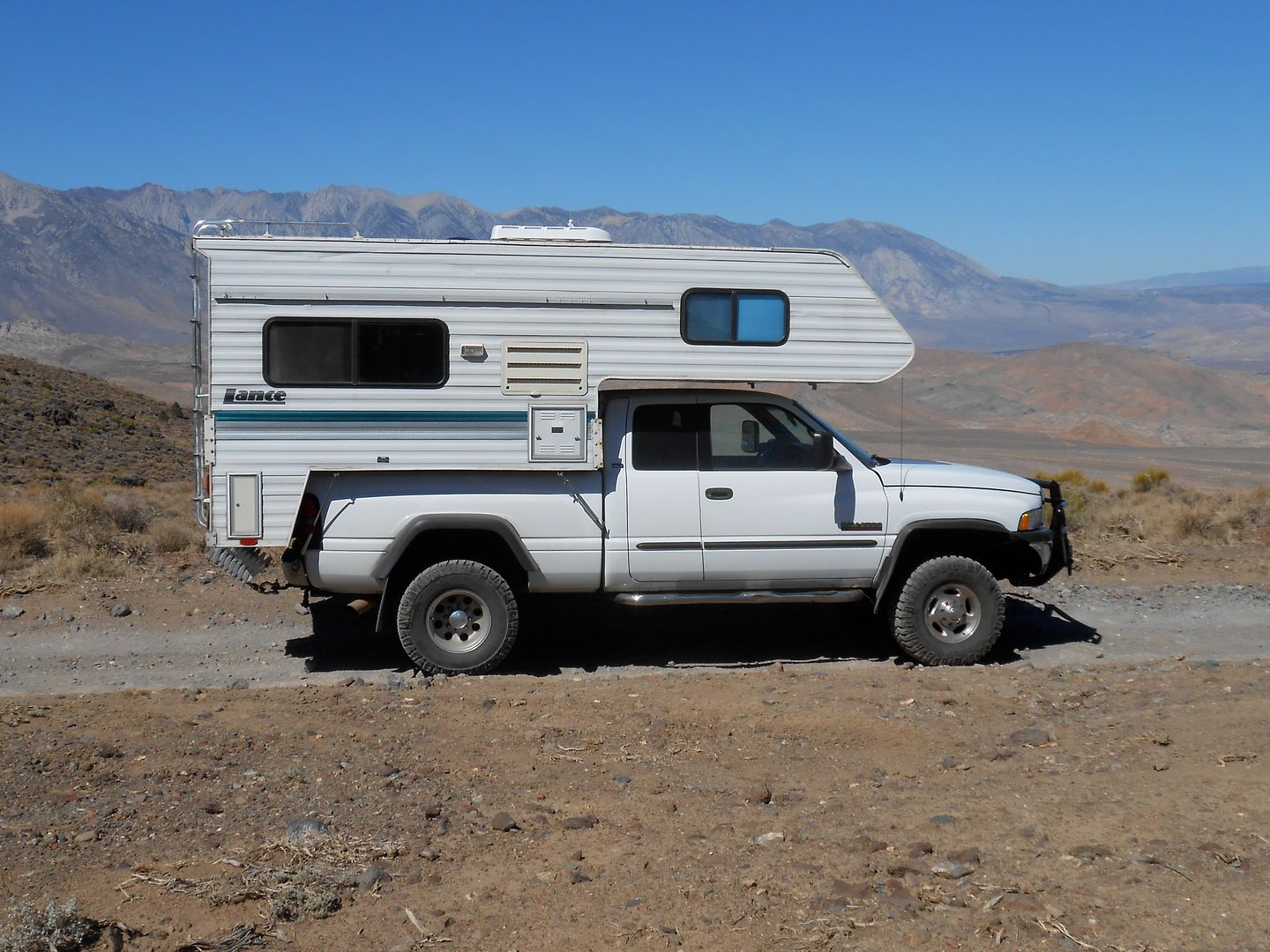 |
| Jefe's 2001 Dodge 2500 and 1998 Lance Squire Lite 165-s. |
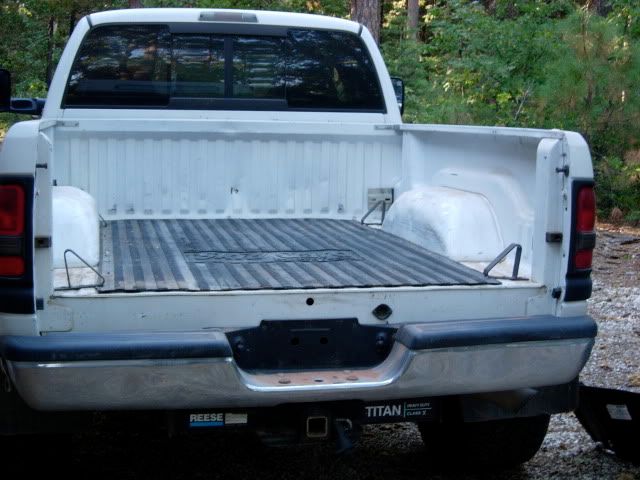 |
| Jefe's truck bed showing the rubber bed mat and brackets. |
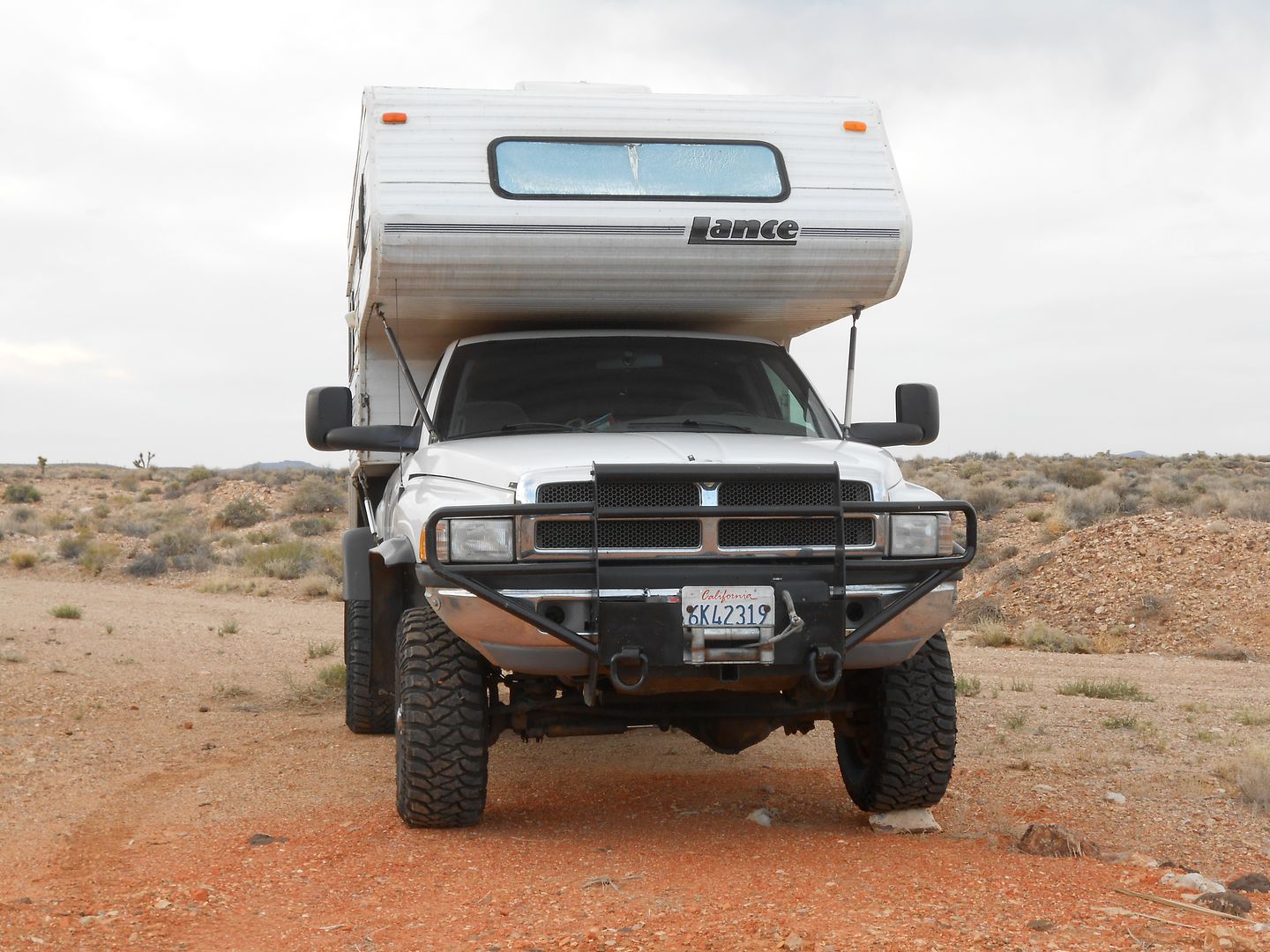 |
| Jefe's "bovine deflecting" Warn winch bumper. |
Mike: What modifications have you made to your truck camper and why did you decide against going solar?
Jefe: Solar power is very inviting, but with all those tree branches dragging on the aluminum roof and the weight of solar panels up high, I think I’ll pass for this lifetime. I purchased the model with no air conditioning, nor a built-in generator to keep the weight down. On off-season trips we take the Honda EU2000i on the off chance we need to run a house current device or charge batteries. I have some mods I’d like to make on the truck camper. I would like to loose both the front window and the pass through window as I find them useless and only there to transmit cold and heat, add weight and leak. If I had the 4-season insulation package, I would be happy as we are non-summer campers. In the end, I think I bought the right truck camper for us as there is very little I would change. You know, if it’s paid for, it fits your needs; and you are accustomed to and can work around its foibles, you might be a happy camper.
Mike: What pickup truck do you presently drive and why did you choose that make and model?
Jefe: I purchased my 2001 Dodge 2500 4x4 pickup truck brand new at the dawn of the diesel wars. I purchased it because it was the first year for a 35 spline, Dana 80 rear axle, the Cummins HO turbo diesel engine that used a bullet proof NV6500, 6-speed transmission, an NV241HD (wide chain to absorb the shock loading during snow plowing), disc brakes all around, and could run on third-world diesel fuel with pretty good mpg. No smog device. No soot bag. No urea canister. Not as simple as the first generation Cummins, but with a much more stout drive train. My choices had to do with tradeoffs. Notice my choice was focused on drive train strength and survivability, certainly not Dodge’s notoriously flimsy fit and finish. Oh, and it was the only truck engine and drive train that year in which I had any confidence about it outlasting me. So far, so good at 150,000 miles.
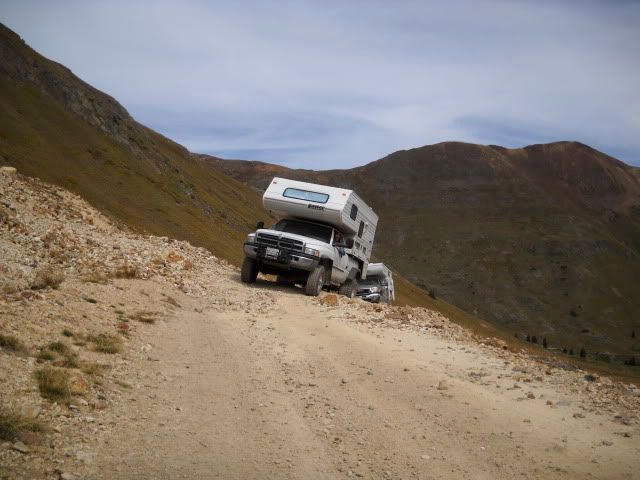 |
| Climbing up the Colorado Engineer Pass 4x4 trail. |
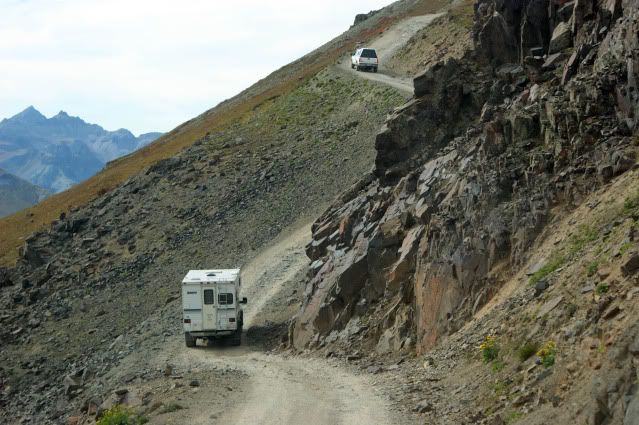 |
| Another view of the Engineer Pass 4x4 trail. |
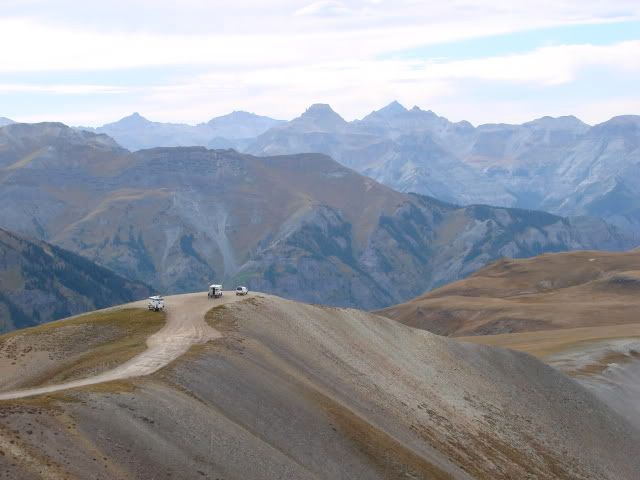 |
| Oh Point from Engineer Mountain in Colorado. |
Mike: What off-road modifications have you made to your truck?
Jefe: If you choose your truck camper well, most of your mods will be to the truck. During the last decade I've made the following mods:
- Steering box/frame brace. This cured the "wanderlust.
- Warn 15000 lb Winch and Warn lightweight bovine deflecting bumper with 26,000 lb cement mixer "D" rings and front receiver hitch.
- Power Lok rear limited slip (clutches under high preload)
- Mickey Thompson super single or "Duplex" 33-inch tires/wheels on the rear axle. 375x55R16 on 12-inch wide forged aluminum wheels.
- A 3-inch spring lift with 8 leaves on the rear and shocks.
- Changed front 4-links to longer ones to locate the front axle 1-1/2 inches forward for more fender clearance for 34 inch tires and as a caster cure.
- New Gen IV track bar (panhard rod).
- Changed the dreaded Carter lift pump to a much-improved aftermarket fuel pump on the frame in front of the fuel tank, essentially making the pump a pusher not a sucker. This part was the Achilles Heel of the Gen II, Dodge Cummins. Installed a low fuel pressure idiot light to remind me there is still time to save the injector pump if I stop the engine.
- Aftermarket air filter.
- Added some tubing to the waste gate to make the turbo kick-in sooner.
- New 4-inch exhaust system
- New Spyntec "Shorty" complete hub conversion kit for the Dodge front Dana 60 axle. It has wide-spaced, larger Timken bearings, and from the outer U-joint outbound uses Dana 70 parts including the 35 spline stub shafts (that I am holding above in front of Cabeza de Vaca), and massive Dana 70 Mile Marker interior lockout hubs with a built-in tone ring. This kit replaces the wear prone and completely unserviceable Dodge Unit Bearing assembly. It works on Dana and American Axle Manufacturing (AAM) axles between 2000-2013.
- Class V receiver hitch
- An aluminum cargo rack that will plug into the front or rear receiver hitch. It can hold extra yellow plastic fuel cans and boxes of goods including recovery gear.
Jefe: At one time I did a lot of towing with the GCVW above 16,000 lbs. For big and heavy I like an oil burner. It's just more efficient than a gas engine. I’ve had many diesel cars (1964 MB200D, 1979 Cadillac Seville diesel, 1980 International Harvester Scout II Traveller Nissan TD, 1981 VW Dasher diesel, and 1983 Peugeot 505S TD) and I got used to the quirks of oil burners. If I were to buy another, say, 350/3500 that would only see occasionally use, I would look for a used Ford or Dodge V-10 gas platform. If you are not in it for the very long haul, or do not plan on much driving, the V-10 gas gets the job done without the $5,000-10,000 diesel penalty.
Part two of this fascinating and informative interview with Jefe can be found by clicking here.
